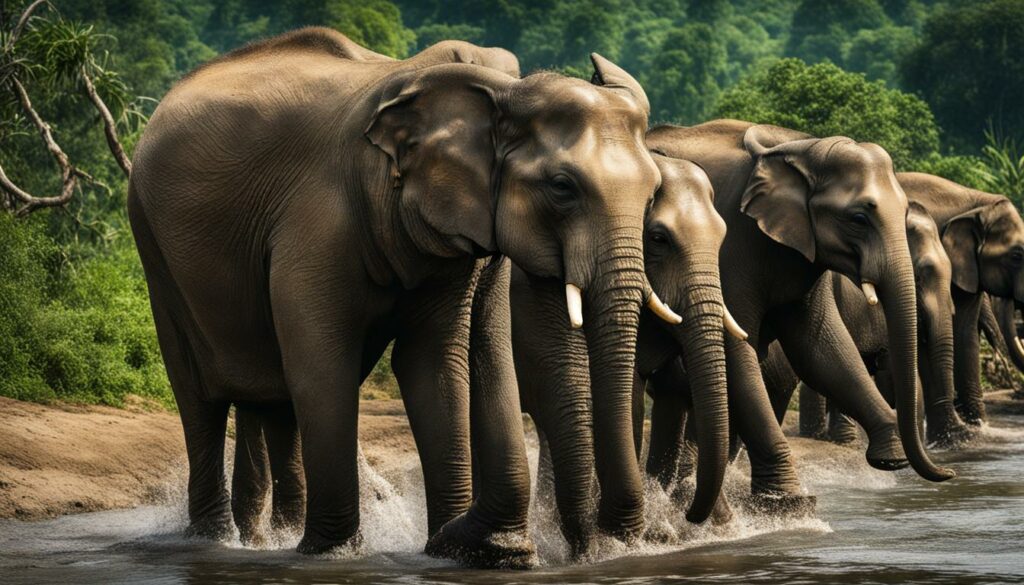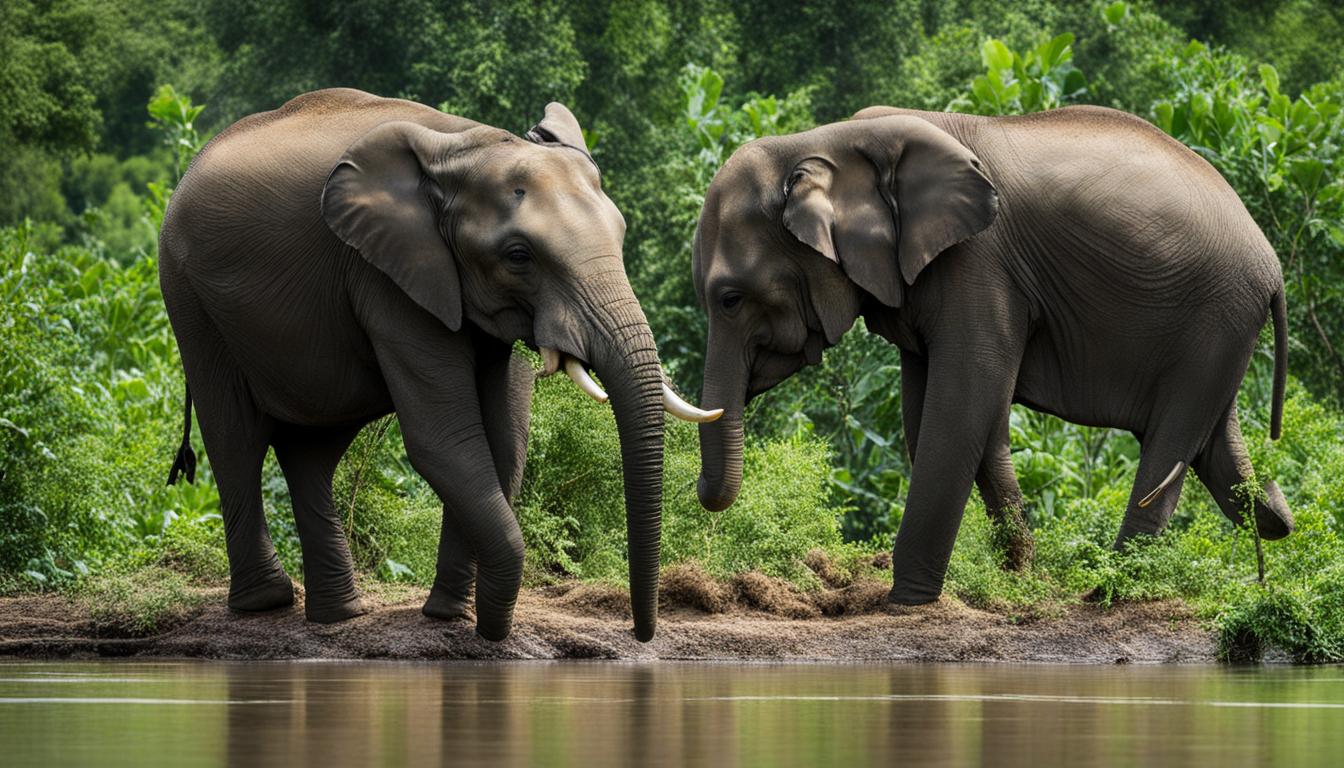Despite a ban on the international trade in ivory, African elephants are still facing grave threats that jeopardize their survival. It is crucial to understand these threats in order to effectively support elephant conservation efforts. In this article, we will explore the main challenges faced by wild elephants and the urgent need for conservation action.
Elephants, majestic creatures known for their intelligence and social behavior, are currently under significant threat from various factors. From poaching for their ivory tusks to human-elephant conflict, habitat destruction, and the thriving illegal ivory trade, elephants are facing unparalleled challenges.
Join us as we delve into each of these threats and the impact they have on elephant populations. Discover the importance of conservation programs and how we can all contribute to protecting these incredible animals from extinction. Let’s raise awareness and take action to ensure a future for elephants.
Human-Elephant Conflict
As elephant populations start to recover and expand their range, a new threat emerges: human-elephant conflict. This conflict arises from the encroachment of human activities into elephant habitats, leading to increased interactions and resulting in negative consequences for both elephants and local communities.
One of the primary drivers of human-elephant conflict is livestock encroachment. Illegal livestock grazing often impacts the availability of food for elephants within protected areas, forcing them to venture outside in search of sustenance. This, in turn, increases the likelihood of elephants encountering humans and leads to retaliatory attacks, causing harm to both parties involved.
The implications of human-elephant conflict are significant for elephant populations. Not only does it pose a direct risk to the survival of these majestic creatures, but it also fosters negative attitudes towards elephants among local communities. This can hinder conservation efforts and perpetuate a cycle of conflict. To address this issue, comprehensive conservation programs are necessary to mitigate the impacts on both elephants and humans.
Table: Examples of Human-Elephant Conflict Mitigation Measures
| Conservation Program | Description |
|---|---|
| Elephant Corridors | Establishing dedicated corridors to ensure safe passage for elephants, reducing the likelihood of human encounters. |
| Community-based Conservation | Involving local communities in conservation efforts, fostering positive attitudes towards elephants, and providing alternative livelihood options. |
| Early Warning Systems | Implementing technologies and strategies to detect elephant movements and alert communities, enabling timely response and prevention of conflicts. |
| Education and Awareness | Raising awareness among local communities about the importance of elephant conservation, emphasizing coexistence, and promoting responsible behavior. |
The successful implementation of these conservation measures requires collaboration among various stakeholders, including local communities, governments, NGOs, and international organizations. By addressing the underlying causes of human-elephant conflict and promoting harmonious coexistence, we can safeguard both elephant populations and the well-being of local communities.
Habitat Destruction
Habitat destruction is a major threat to the survival of African elephants. As human populations continue to grow, there is a rapid rate of forest clearing and encroachment into elephant habitats. The expansion of agriculture, plantations, mining activities, human settlements, and infrastructure development all contribute to the loss and fragmentation of elephant habitats. This destruction and fragmentation lead to smaller patches of disconnected land, increased food scarcity, and disruption of migration routes.
One of the consequences of habitat destruction is habitat fragmentation, which occurs when large areas of natural habitat are divided into smaller and isolated patches. This fragmentation poses significant challenges for elephant populations as it limits their ability to move freely, find food, and access water sources. It also increases the chances of human-elephant conflicts as elephants are forced to venture into human settlements in search of resources.
Overgrazing is another factor contributing to habitat destruction and food scarcity for elephants. As human populations expand, the demand for livestock grazing areas also increases. This leads to overgrazing, which not only reduces the availability of food for elephants but also for livestock. As a result, conflicts between elephants and farmers escalate, further endangering the survival of these majestic creatures.
Impact of Habitat Destruction on African Elephant Conservation
The destruction and fragmentation of elephant habitats pose a significant threat to African elephant conservation efforts. By reducing the size and connectivity of their habitats, elephants become more vulnerable to natural disasters, diseases, and genetic isolation. These factors can have long-term consequences for the survival and genetic diversity of elephant populations.
The loss of habitat also disrupts the delicate balance of ecosystems, impacting not only elephants but also other wildlife species that depend on these habitats for their survival. Protecting and restoring elephant habitats is crucial for the overall health and biodiversity of ecosystems.
| Threat | Impact |
|---|---|
| Habitat destruction | Loss and fragmentation of elephant habitats, disruption of migration routes, increased human-elephant conflicts |
| Habitat fragmentation | Limitation of elephant movement, reduced access to food and water sources, increased vulnerability to natural disasters and diseases |
| Overgrazing | Food scarcity for elephants and livestock, escalation of conflicts between elephants and farmers |
“The destruction and fragmentation of elephant habitats are major threats to their survival. As Africa’s human population grows, there is an unprecedented rate of forest clearing and encroachment into elephant habitats.” – Conservationist
The Ivory Trade
The illegal ivory trade remains a significant threat to both African and Asian elephant populations, despite the ban on international trade. Demand for ivory products in Asia, especially in China, continues to drive the poaching and trafficking of elephants for their tusks. Recent studies estimate that between 2010 and 2012, approximately 100,000 elephants were killed for their ivory in Africa alone. This devastating trade not only poses a risk to the survival of elephants but also fuels organized crime and insecurity, with traffickers using the same networks as other illegal goods.
The consequences of the ivory trade are far-reaching and severe. Elephants are targeted for their tusks, which are smuggled across borders and sold on the black market for exorbitant prices. This rampant demand for ivory perpetuates the cycle of poaching and illegal trade, leading to a decline in elephant populations. Both African and Asian elephants are vulnerable to this trade, with their numbers declining at alarming rates.
Efforts to combat the ivory trade are crucial for elephant conservation. International collaborations and strong law enforcement measures are necessary to dismantle the networks involved in trafficking ivory. Additionally, raising awareness about the devastating effects of the ivory trade and promoting sustainable alternatives to ivory products can help reduce the demand for illegal ivory. By addressing this critical issue, we can contribute to the protection and preservation of these majestic creatures and ensure their survival for future generations.
“The ivory trade not only threatens the very existence of elephants but also has significant implications for global security and the fight against organized crime.” – Elephant Conservation Society
African Elephant Conservation vs. Asian Elephant Conservation: A Comparison
| African Elephants | Asian Elephants | |
|---|---|---|
| Habitat Destruction | African elephants face habitat destruction due to forest clearing, encroachment, and infrastructure development. | Asian elephants are threatened by habitat loss caused by deforestation, agriculture, and infrastructure expansion. |
| Human-Elephant Conflict | Human-elephant conflicts arise due to encroachment on elephant habitats, leading to increased chances of retaliatory attacks. | Similar to African elephants, Asian elephants also experience conflicts with humans, particularly in areas where agriculture and settlements encroach on their habitats. |
| Poaching | Poaching for ivory remains a significant threat to African elephant populations. | Asian elephants are poached for their tusks, skin, and meat, contributing to their decline. |
| Conservation Efforts | Various conservation programs focus on anti-poaching measures, habitat protection, and community engagement to safeguard African elephants. | Conservation efforts for Asian elephants include habitat preservation, increasing wildlife protection, and promoting sustainable livelihoods for local communities. |
While the threats faced by African and Asian elephants share similarities, the specific circumstances and conservation strategies required differ due to variations in habitat and regional challenges. Both African and Asian elephant conservation efforts play crucial roles in safeguarding these magnificent creatures, ensuring their survival and the preservation of their ecosystems.
Asian Elephant Conservation
Asian elephants, particularly Sumatran elephants, are facing numerous threats that put them at risk of extinction. One of the biggest challenges is habitat destruction. The expansion of human activities such as agriculture, plantations, mining, settlements, and infrastructure development has led to the loss and fragmentation of elephant habitats. As a result, the remaining elephant populations become smaller and isolated, making them vulnerable to natural disasters and in-breeding. This is a critical issue that needs urgent attention and conservation efforts.
Poaching is another major threat to Asian elephants. These magnificent creatures are targeted for their ivory, skin, and meat. The illegal wildlife trade fuels the demand for these products, putting immense pressure on elephant populations. Efforts must be made to strengthen anti-poaching measures and combat the illegal wildlife trade to safeguard the future of Asian elephants.
Conservation programs play a vital role in protecting Asian elephants. By focusing on habitat protection, community engagement, and raising awareness, these programs can help mitigate the threats faced by elephants. Creating protected areas, training rangers to combat poaching, and promoting sustainable livelihoods for local communities are some examples of conservation initiatives that can make a difference. International support and cooperation are crucial in ensuring the long-term survival of Asian elephants and securing their place in the natural world.

Table: Asian Elephant Conservation Program Overview
| Conservation Programs | Focus Areas | Impact |
|---|---|---|
| Establishment of Protected Areas | Preserving elephant habitats, providing safe spaces for elephants to thrive | Preventing habitat destruction, supporting sustainable elephant populations |
| Ranger Training | Building capacity to combat poaching, enhance anti-poaching efforts | Reducing elephant mortality due to poaching, protecting populations |
| Community Engagement | Involving local communities in conservation efforts, promoting coexistence | Reducing human-elephant conflicts, gaining community support for conservation |
| Awareness and Education | Raising awareness about the importance of elephant conservation | Changing attitudes and behaviors, fostering a culture of conservation |
Through these conservation programs, we can work together to protect Asian elephants from the threats they face. By addressing habitat destruction, poaching, and promoting coexistence, we can ensure a future for these incredible creatures. It is our responsibility to take action and contribute to the conservation of Asian elephants, preserving their beauty and uniqueness for generations to come.
Elephant Conservation Programs
To address the numerous threats facing elephants, various conservation programs have been established. These programs focus on anti-poaching efforts, habitat protection, community engagement, and raising awareness about the importance of elephant conservation. By implementing these initiatives, we can work towards safeguarding the future of both African and Asian elephants. Let’s take a closer look at some of the key conservation programs:
Anti-Poaching Measures
One crucial aspect of elephant conservation programs is the implementation of robust anti-poaching measures. This involves training and equipping rangers to effectively track and apprehend poachers. Anti-poaching units are deployed in high-risk areas to patrol and monitor elephant populations. By deterring and apprehending poachers, these measures help curb illegal hunting and protect elephants from further harm.
Habitat Protection
Preserving the remaining natural habitats of elephants is vital for their survival. Conservation programs work towards establishing and managing protected areas that serve as havens for elephants. These areas are carefully monitored to prevent encroachment, illegal logging, and other activities that lead to habitat destruction. By safeguarding their habitats, we can ensure that elephants have sufficient food, water, and space to thrive.
Community Engagement
Engaging local communities is a key component of successful elephant conservation programs. These initiatives aim to foster positive relationships between communities and elephants, reducing conflicts and promoting coexistence. By providing educational programs, alternative livelihood opportunities, and incentives for community participation in conservation efforts, these programs help create a shared responsibility for protecting elephants and their habitats.
Raising Awareness
Another important aspect of elephant conservation programs is raising awareness about the threats facing these magnificent creatures. Through public campaigns, educational initiatives, and outreach activities, organizations seek to educate people about the importance of elephant conservation and the role individuals can play in protecting them. By increasing public awareness, we can promote a collective effort to save elephants from extinction.
| Conservation Program | Main Objectives | Funding Source |
|---|---|---|
| Elephant Patrols | Prevent illegal poaching and monitor elephant populations | Government grants, private donations |
| Habitat Restoration | Restore and protect elephant habitats | Conservation organizations, corporate sponsorships |
| Community Outreach | Engage local communities and promote coexistence | NGO partnerships, community contributions |
| Education and Awareness Campaigns | Raise awareness about elephant conservation | Grants, fundraising events |
By supporting these elephant conservation programs, we can contribute to the preservation of these majestic creatures and help ensure a brighter future for elephants across the globe.
Conclusion
The threats facing wild elephant populations, including poaching for ivory, human-elephant conflict, habitat destruction, and the ivory trade, have resulted in a significant decline in elephant numbers in both Africa and Asia. To protect these majestic creatures from extinction, it is crucial to prioritize elephant conservation efforts.
Conservation programs, such as anti-poaching measures, habitat protection, and community engagement, play a vital role in safeguarding elephants. By raising awareness about the challenges they face and the importance of their conservation, we can contribute to their survival.
Together, we can help protect elephants from the devastating impacts of poaching, mitigate human-elephant conflicts, prevent habitat destruction, and combat the illegal wildlife trade. Through our collective efforts, we can secure a future for these incredible animals and ensure their continued existence for generations to come.
FAQ
What are the primary threats facing wild elephant populations?
The primary threats facing wild elephant populations include poaching for ivory, human-elephant conflict, habitat destruction, and the ivory trade.
What is human-elephant conflict?
Human-elephant conflict refers to conflicts that arise when elephants and humans come into contact and compete for resources. This often leads to retaliatory attacks against elephants, posing a significant threat to their populations.
What is habitat destruction?
Habitat destruction refers to the destruction and fragmentation of elephant habitats, primarily caused by human activities such as forest clearing, agriculture expansion, mining, and infrastructure development. It disrupts migration routes and reduces food sources for elephants, contributing to their decline.
What is the ivory trade?
The ivory trade refers to the illegal trade in elephant ivory, which fuels poaching and threatens elephant populations. China is the largest consumer market for ivory products, despite a ban on international ivory trade.
What is the situation of Asian elephant conservation?
Asian elephants, particularly Sumatran elephants, are facing extinction due to habitat destruction, human-elephant conflict, and poaching. The expansion of human activities has resulted in smaller and isolated elephant populations, making them vulnerable to natural disasters and in-breeding.
What are elephant conservation programs?
Elephant conservation programs are initiatives aimed at protecting and preserving elephants. They involve anti-poaching efforts, habitat protection, community engagement, and raising awareness about the importance of elephant conservation.
How can I contribute to elephant conservation?
You can contribute to elephant conservation by raising awareness, supporting conservation programs, and combating the illegal wildlife trade. By taking these actions, we can help ensure a future for these iconic animals.











